By Lucy Komisar
Aug 22, 2006 [Part 1]
[Here is Part 2: Vendetta]
As Secretary of HUD, Andrew Cuomo reversed the policy of selling defaulted mortgages so that families could keep their homes. Instead, he chose to foreclose on mortgages, which meant that families lost their homes and insiders cleaned up on fire-sale priced properties. The U.S. Treasury also lost billions.

On September 12th, a primary will choose the Democratic candidate for New York Attorney General. The front runner is Andrew Cuomo.
Cuomo seeks to succeed Eliot Spitzer, who made a national reputation by targeting corrupt Wall Street and corporate officials. Spitzer has been publicly denounced by his targets, including former AIG chairman Maurice “Hank” Greenberg, accused of cooking the books to present a fraudulent picture of his company‘s financial position.
In December, Cuomo‘s father, former Governor Mario Cuomo, announced he was helping to launch a public relations campaign on Greenberg’s behalf.
Would Attorney General Andrew Cuomo go after Greenberg or other high-profile miscreants? A look at his tenure as Bill Clinton‘s Secretary of Housing and Urban Development raises serious doubts.
When Cuomo became HUD Secretary in 1997, he axed a federal program that had saved the U.S. $2.2 billion between 1994 and 1997 and reinstituted a system that lost the government money while earning billions for favored friends. He fired a former HUD official whose company designed the program.
That wasn‘t the only big money lost. When Cuomo was secretary, HUD reported that $59 billion was missing! It couldn‘t say where they money went, because it failed to produce audited financial statements.
The Department of Housing and Urban Development is renowned for corruption. Historically, fraud has been so pervasive and blatant that the Sopranos episode on it was disturbingly realistic.
Season 4, Episode 46: Senator Zellman, Maurice Tiffen and Tony meet at a Russian Bath House and hatch the latest investment scheme to defraud New Jersey HUD (this is a federal sponsored program, not New Jersey, Housing and Urban Development). All Maurice‘s minority organization has to do is take ownership and mortgages on dilapidated properties and the NJHUD will assume the lending risks involved. In the end, everybody will leave with a piece of the pie.
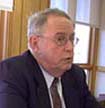
Jack Blum, a Washington lawyer, in the mid-1970s was the chief investigator for Senator Frank Church‘s subcommittee on multinational corporations. He exposed the Lockheed bribery scandal and other examples of corporate corruption. Later, he headed Senator John Kerry‘s investigations into Iran Contra drug connections and the corrupt bank, BCCI. Blum says, “I know about HUD since the 1970s — the fake mortgages. It‘s been going on forever. She [the former HUD official] doesn‘t understand that what she got caught up in is part of a pattern.”

This story starts in 1989 with Catherine Austin Fitts, then a savvy Wall Street investment banker.
Fitts, who everyone called “Austin,” had an establishment pedigree. She was graduated from the Wharton School of Business at the University of Pennsylvania in 1978. She was a partner at Dillon Read, the white shoe investment firm headed by Nicholas Brady, where she made a name for herself when she recapitalized the New York City subway and bus systems and arranged funding for the City University of New York. A February 23, 1987 Business Week article called her the Wonder Woman of Muni Bonds. She was a high-profile, successful, Wall Street Republican who knew a lot about financial management.
Fitts got the chance to join the new George H.W. Bush administration as Assistant Secretary of Housing. She recalls, “When I told Nick Brady [who‘d become Bush‘s Treasury Secretary] that I was going to work at HUD, he said, “You can‘t go to HUD ” HUD is a sewer.”
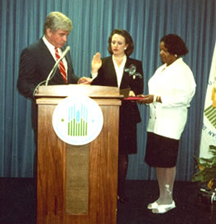
She discovered Brady was right. Working for HUD Secretary Jack Kemp, she saw him run the agency to generate fees for friends.
One of them was Andrew Cuomo. Fitts says that in 1989, Kemp ordered her to allocate “Section 8” rental subsidies without a competitive process. These were subsidies that went directly to builder/landlords for apartments they would rent at below market rates. She says that when she refused to award subsidies illegally, they were surreptitiously approved by staff while she was out of town. She got them stopped by appealing to the HUD General Counsel. One of Fitts‘s deputies told her later that the illegal payments were for Cuomo‘s Housing Enterprise for the Less Privileged (HELP).
A spokesperson for Kemp declined to comment on the record. Chris Greer, then head of the HUD Inspector General‘s audit team, said, “This is an accurate description. It amazed us in OIG [Office of Inspector General] at the time as Congress was in midst of holding hearings on the HUD scandal involving the Mod Rehab [Section 8] program. There is little evidence about Cuomo on this as Fitts stopped the deal.”
When Bill Clinton was elected President, he appointed former San Antonio mayor, Henry Cisneros, to head HUD. HUD then awarded a contract to Fitts‘s company, Hamilton Securities, to reform the system of dealing with FHA defaulted mortgages.
But Cisneros was forced out by a convenient sex scandal – lying about the amount of, but not the fact, of payments to a former girlfriend. Cuomo, appointed to take Cisneros‘s place, was not held to the same standard. After Cuomo was nominated for the post, he lied in a form filed with the Senate Banking, Housing, and Urban Affairs Committee by failing to admit that he had been under investigation by federal banking regulators for bank fraud, for participating in a group that surreptitiously tried to take over a Florida savings bank. Attorney General Janet Reno, who had spent at least $9 million in a four-year investigation of Cisneros‘s girlfriend problem, declined to look into Cuomo‘s link to bank fraud.
This story begins with Fitts‘s discovery of the Bush fees for friends operation, because that‘s what Cuomo reverted to after Cisneros left.
Fitts had been appointed to run HUD‘s Federal Housing Administration (FHA), which insures mortgages so that home-buyers can borrow at reduced rates. Or so that landlords can offer below-market rents for tenants.
In 1989, HUD had $320 billion in mortgage insurance outstanding and was originating $50 to $100 billion of new mortgage insurance a year. Its largest fund provided mortgage insurance for single family homes. It also provided mortgage insurance for apartment buildings, hospitals, and nursing homes.
If the borrowers defaulted on FHA insured mortgages, the government would take over the loans. HUD could foreclose and sell the properties on the market or it could hire contractors to collect rent and manage the properties.
Dealing with billions of dollars in defaulted mortgages, Fitts discovered that the big-time beneficiaries of the HUD system were political friends. Sometimes, insiders kept their properties even though they did not pay their mortgage debts. Or defaulted mortgages and foreclosed homes were sold to favored investors at below market prices. Or friends got big contracts to manage large inventories of defaulted properties.
These scams lost taxpayers billions of dollars every year, skimming off monies that were supposed to be returned as refunds to homeowners with FHA mortgages or to support government programs for affordable housing.
But the system was designed to hide such dodgy operations. When Fitts arrived at HUD, she discovered the books were a mess. She ordered an accounting of FHA finances, including of HUD mortgages and properties in each city.
She discovered that, “The data base would show you had a building on a property. You‘d go to that place and get off the plane and there was nothing there. We also had neighborhoods where you had significant default patterns that didn‘t make any sense — properties that defaulted one, two, three times in a year. You‘re losing huge amounts of money and neighborhoods were being harmed and it didn‘t make any sense.”
She persuaded Secretary Kemp and the Office of Management and Budget of the need for audited financial statements. She helped design and draft the HUD Reform Act of 1989, which required the agency to publish annual audits. It was the basis of a later law requiring all federal agencies to do the same.
Greer confirmed that, adding, “What I liked most about Fitts when she was at HUD as Assistant Secretary and later as a contractor was the fact that she was a stickler for accountability and financial integrity. She did much to improve that at HUD.”
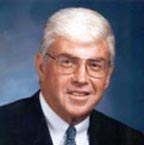
Fitts had many run-ins with Kemp over what she came to see as fees for friends. In one case, she said, Kemp wanted to provide financial relief to Puller Mortgage, an Indiana company which in 3-and-a-half years had originated more than $400 million in FHA mortgage insurance on multi-family properties. The majority of the mortgages were for projects where the first year-and-a-half to three years‘ payments were deducted in advance from the money supplied, so no payments had to be made until rents came in.
But Fitts discovered that the portfolio already had an 18-percent default rate. She asked her staff how that could possibly be. They informed her nervously that company founder Ken Puller was a major Republican contributor. Fitts ruled that Puller Mortgage would not get special financing to cover the suspicious losses. She said that Kemp, furious, summoned her to his office and shouted, “How dare you shut Puller down!”
A Kemp spokesman declined to comment. Chris Greer said, “Puller Mortgage was a very bad lender costing HUD millions of dollars over the years. HUD did provide such relief on several occasions. Puller was subject to many audits and investigations, and Fitts was involved in discontinuing that relief and getting him debarred. Puller definitely had Republican connections.”
Fitts repeatedly opposed political favors, and in August 1990, after 18 months, Kemp fired her.
HAMILTON
When Fitts left HUD, she started the Hamilton Securities Group, Inc.,![]() a Washington investment bank that developed specialized financial software and provided financial advisory and investment banking services for public and private clients. The firm was named after the first U.S. Treasury Secretary, Alexander Hamilton, whom Fitts admired because he had insisted on paying the debt of the Confederation of States that preceded the nation‘s founding.
a Washington investment bank that developed specialized financial software and provided financial advisory and investment banking services for public and private clients. The firm was named after the first U.S. Treasury Secretary, Alexander Hamilton, whom Fitts admired because he had insisted on paying the debt of the Confederation of States that preceded the nation‘s founding.
She was still highly thought of in top official circles. Bush‘s Treasury Secretary Nick Brady asked her to serve as a Governor of the Federal Reserve, but she declined. John Sununu, Bush White House Chief of Staff, had her appointed to the board of Sallie Mae, the government-sponsored corporation that helps provide financing for student loans.
Harry Albright, selected by New York District Attorney Robert Morgenthau to resolve the failure of Washington‘s First American Bank, which involved former Defense Secretary Clark Clifford and the corrupt, money-laundering bank, BCCI, put her on a board to help with the clean-up. Albright had been Chairman of Battery Park City Authority when Hamilton was its financial advisor. Albright says now, “I thought highly of her; I thought she was a person of great integrity.” Hamilton‘s software and database innovations prompted Federal Reserve Chairman Alan Greenspan to invite it to brief Federal Reserve staff about its research into institutional equity investment in real estate.
Then Fitts got another chance at HUD reform. After Bill Clinton became President, Hamilton in 1994 won a competitive bid to serve as the lead financial advisor to the FHA under HUD Secretary Henry Cisneros.
By the time the Clinton team came in, defaults on HUD-insured properties were so enormous, that HUD staff was unable to handle the servicing of mortgages transferred to it when it paid insurance claims by the original lenders. There was $12 billion in defaulted mortgages: $4 billion on single-family homes and $8 billion on multi-family projects.
Hamilton‘s analysis at the time showed an industry average recovery rate on defaulted single-family mortgages of 75 cents on the dollar. But in 1993 and 94, HUD had a recovery rate of only 35 cents. Based on this loss, HUD would need huge Congressional appropriations to continue to issue mortgage insurance for the homes and apartment buildings Americans needed.
When FHA took back defaulted single-family mortgages, in most cases it foreclosed, took physical possession of the properties and sold them. Until the sale, it would hire a contractor to manage the properties. Hamilton began to consider whether HUD should switch from a policy of foreclosing to a policy of selling the mortgages. That would keep many people from losing their homes and would also help neighborhoods, since when properties were empty and deteriorated, community housing values dropped.
Reviewing information on HUD mortgage portfolios, Hamilton found patterns that Fitts later realized showed systemic fraud. They could have been Sopranos stories. It appeared that some mortgages were financing homes with appraisals inflated above market prices, that some defaulted mortgages or foreclosed homes owned by HUD were being passed back to private parties at below market values, and that some mortgages were for ghost properties.
She also suspected money laundering. She said, “We found one HUD-owned multi-family mortgage in 1994 that had been in default for 11 years, with no debt service payments, and yet the property had a cash flow.” She explained, “HUD was intentionally not collecting payments in situations where there was sufficient cash flow to do so. Why? On several occasions, I had owners tell me that they had been promised various things outside of their contracts. Then they would freeze and not explain. These side deals seemed to have more weight than the actual contracts.”
Fitts said, “I believe that one of the reasons that some people in the business wanted to continue the practice of foreclosing on defaulted mortgages rather than selling them is that on foreclosure, the mortgage is extinguished. If a fraudulent mortgage is sold, the buyer acquires evidence of the fraud.”
Traditional beneficiaries of the existing system included big time developers and property management companies such as the Harvard Endowment-owned National Housing Partnership (NHP), Andrew Farkas‘ Insignia, and mortgage bankers such the NHP-affiliated Washington Mortgage (WMF). NHP managed a complex web of private partnerships that had been set up as real estate tax shelters.
Fitts wanted to break up the monopoly system that allowed a select group to make money at taxpayers‘ expense. She wanted to broaden participation in mortgage auctions to enable local interests that might know and care about their own towns and neighborhoods to acquire properties at fair market prices.
She wanted to stop insider deals. She said, “I‘ll never forget meeting with owners of apartment properties with mortgages that had been acquired by HUD, mostly because they were in default. When we explained we planned to sell their mortgages at competitively bid sealed auctions, they went wild. They said, ‘But we have a deal.’ When I would say, ‘Can you be more specific?’ they would shut up and walk away. Everything was run according to deals, and we weren’t allowed to know what they were. A couple of people came to me and swore that 100, 200, 300 properties were transferred secretly to this or that guy as part of a political deal. That would help explain the low recovery rates.”
Hamilton developed and instituted a computer program  that optimized the sale of defaulted FHA mortgages, making it much easier for a more diverse pool of bidders to participate. It did this with its own analytic software tools and with optimization bidding software which it contracted from AT&T’s Bell Labs (now Lucent Technologies).
that optimized the sale of defaulted FHA mortgages, making it much easier for a more diverse pool of bidders to participate. It did this with its own analytic software tools and with optimization bidding software which it contracted from AT&T’s Bell Labs (now Lucent Technologies).
The bids were put into a computer model which figured all possible combinations and calculations and then picked the bids that made the most money for the FHA. The new bidding system, which included online access to portfolio and bidding information, meant that HUD attracted new investors interested in buying defaulted mortgages and therefore got higher recoveries on those mortgages. Fitts said, “The big, medium guys and little guys had never competed so directly before in the distressed mortgage markets. It drove the competition off the charts. You couldn’t out-game it.”
Fitts explained, “If you‘re a securities firm, you want to buy a lot at once, say $300 million worth to sell in the mortgage-backed securities market. If you’re a mortgage firm, you may want to buy one by one, but of a certain size. If you‘re a small real estate firm, you’re happy to buy one. If you‘re a large real estate firm, you may want all of HUD‘s mortgages on certain types of properties in several places.”
Hamilton‘s first large HUD loan sale, “the SouthEast,” in spring 1995 was a roaring success. The big winner was GE Capital which, along with some small bidders, paid $710 million for a portfolio that HUD staff had valued at only $286 million. The performance stunned both traditional HUD constituencies and Wall Street. Fitts recalls, “When I told the HUD IG audit team the results, there was a long silence, and then Chris Greer, the head of the team, said, ‘What this means is that we have been getting screwed all along. By a lot.’” Greer confirmed that.
Fitts said, “By running the inside baseball game, HUD had been losing a huge amount. This was a wake-up call to guys at HUD that when you have transparency and competition you could significantly improve recovery rates.” It meant that Congress could appropriate less money to fund new mortgage insurance.
In a series of sales run by Hamilton between 1994 and 1997, HUD sold 98,640 single-family mortgages and 1,093 multi-family mortgages that represented $10 billion in mortgage debt. Recovery rates on these defaulted mortgages were 70 to 90 percent, up from HUD‘s previous 35 percent. These sales generated more than $2.2 billion, allowing HUD to issue more new mortgage insurance at a lower cost.
An article in the April 10, 1995 issue of Barron’s, declared, Believe It or Not, HUD Finally Does Something Right for Taxpayers. (The reporter, James McTague, no fan of the agency, wrote that leaving a mortgage loan at HUD for servicing was like leaving your car on the side of the Cross Bronx Expressway for a tune-up.)
The higher recovery rates would also affect homebuyers positively. Fitts explained, “If you charge mortgage insurance premiums and make a profit in the single-family fund, you are supposed to refund that back to the people financing the homes. If you have a mutual mortgage insurance fund and run it at a lower-than-optimal recovery rate, it is a way of cheating the largely non-defaulting single-family borrowers, as a group, out of their premium refunds to support lower premiums for the high-risk multi-family borrowers, whose mortgages had higher default rates.”
“HUD is charging more money than necessary for the single-family premiums. They skim off the premium profits and transfer it to their pals in the housing sector. This hurts millions of Americans using FHA mortgage insurance to finance their homes.” America‘s home-owners were being cheated.
“While the loan sales were a great success for taxpayers, homeowners and communities,” she noted, “it turned out that they were a significant threat to the traditional interests that fed at the trough of HUD programs, contracts and mortgage operations.” HUD officials and investors realized that the loan sale program was going to be a success and lead to changes in control over the multi-family mortgage portfolio, transferring it into the hands of high bidders rather than the good ole boys who had had so much influence over HUD for years.
Fitts explained, “You had a variety of parties making money on HUD‘s holding onto large portfolios of defaulted loans. And we were now requiring investors like Harvard Endowment to pay full price for the mortgages on their own assets. That meant they had to finance the projects at 70 to 90 percent rather than 35 percent of the old debt. That affected the insider developers and property management companies.”
In January and April of 1996, still under Cisneros, a new HUD contract was awarded to Hamilton to serve as the FHA‘s lead financial advisor for $10 million a year for two years. HUD also appointed three other firms — Merrill Lynch, Cushman & Wakefield and Ernst & Young — as financial advisors.
That year, Cindy Ecker at the HUD Denver IG [Inspector General] office began an audit of the loan sales program. After she collected the data, she told loan sales managers that they had done a terrific job and that she was going to write a glowing report. Fitts expected the audit to be issued in August or September. But it didn‘t appear. Fitts later found out that Ecker had refused to change her favorable audit and, at the request of the IG, to be critical of the loan sales program.
Michael Stegman worked as head of the HUD Office of Policy Development and Research and then was acting Chief of Staff at the end of the Cisneros term and beginning of Cuomo‘s tenure. He is now Director, Center for Community Capitalism, at the Institute of Private Enterprise, the University of North Carolina. He said the Hamilton project was “really innovative and, from what I recall, was returning to HUD more money on the dollar than was existing methods for disposing of HUD-held assets.”
But policies that benefited homeowners and taxpayers didn‘t seem to be HUD‘s priority. Fitts recalled, “In 1995, we were finding many places where the costs of rehabbing the property underlying defaulted single-family mortgages held by HUD was significantly cheaper than building new public housing or continuing to renew project-based assistance on private apartment buildings.”
She went to see an official of the Hope VI new public housing program, which is very expensive on a per-unit basis. Fitts pointed out that HUD could spend $50,000 per unit to rehab single family-homes owned by the FHA rather than spending $150,000-250,000 including HUD overhead to create new public housing in the same community. Fitts said that the official replied, “But how would we generate fees for our friends?”
PROTECTING FEES FOR FRIENDS
Andrew Cuomo had been appointed HUD Assistant Secretary of Community Development (CDP) under Cisneros. In 1996, Inspector General audit chief Chris Greer was in a meeting with Cuomo and HUD IG Susan Gaffney. Cuomo told them that he was planning to get rid of Fitts and Hamilton Securities.
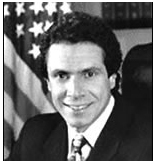
Greer recalled, “It had to do with some audits we were doing. There were proposals that would affect a bunch of folks in New York that had a lot of money and who could help Cuomo. One proposal was called ‘mark to market’ and had to do with the Section 8 [rental subsidies] program. I was managing all the multi-family programs at the time. Cuomo wanted to do away with what we tried to put in place, the ‘mark to market’ program. It would have killed a HUD tax-avoidance program.”
Mark to market means assigning a value based on the current market price. Fitts explained, “Mark to market aimed to deal with a huge problem that was starting to rear its ugly head in the mid-90s when the bad decisions of the previous 30 years caught up with HUD. It had issued 30-or 40-year mortgage insurance to finance multi-family properties for low-income tenants. It had also issued Section 8 rent subsidy contracts that were project-based [awarded to the owner, not the tenant] to support the same projects. The amount needed pay interest on the debt had climbed above the rents collected by the projects, so in many cases HUD subsidies had increased the Section 8 rents to above-market rates in order to support the HUD-insured debt. Then in the mid-90s, the Section 8 rent contracts expired. HUD renewed the contracts on a year-to-year basis and sometimes issued tenant-based, as opposed to project-based vouchers.”
She noted, “Tenant-based vouchers were unpopular with project owners, because tenants could go to other projects and take the subsidies with them. Hamilton advised HUD that, long-term, the wisest strategy was to keep Section 8 rent subsidies at market rates and take a one-time loss on the HUD-insured debt so that the properties could be refinanced at market rates in the private markets. This strategy, however, would have had a dramatically adverse impact on the project owners such as NHP, whose properties would no longer be propped up by the government.”
Fitts explained the tax issue: “Many of the multi-family mortgages were on apartment buildings that had been financed as tax shelters. Since HUD programs gave rent subsidies to developers rather than tenants, the developers could use HUD mortgages to finance the buildings based on the value created by the subsidies. The tax shelter partnerships used to finance the properties were able to get tax write-offs on the full value of the properties — including that portion of the value created from the subsidy and financed with the HUD mortgages. If the partnership defaulted on the mortgage, HUD might tear up or reduce the mortgage owed, but then investors would be forced to recognize the debt forgiveness as income.” And they would have to pay more taxes.
She said, “Cuomo wanted either to give the defaulting owners more subsidies or reengineer their mortgages, or both, in such a way that bolstered the value of the buildings and let investors keep healthy tax deductions. In other words, he wanted either to pay higher than market rents in the form of Section 8 subsidies, or insure higher than market debt, all at the expense of the taxpayers, in order to avoid the tax consequences to the owner of financing the projects at market rates. Instead of saying what‘s best for the community and taxpayers, to produce affordable housing at the lowest cost to taxpayers, he said, ‘How can we generate fees for our friends.’ There was a tax shelter refinancing pork fest.”
Greer pointed out, “If there had been ‘mark to market,’ it would treat the HUD Section 8 program like private mortgages in private industry and market them at their true values. You wouldn’t have inflated subsidies, and you would have had more subsidies to give more people. Or you would save tremendous amounts of money that could be used for other purposes. Billions of dollars. Hamilton was a driver on that along with a couple of other folks in HUD. But Cuomo didn‘t do it. Money was wasted on these mortgages, the money that went into the fat cats’ pockets.”
He added, “Cuomo clearly had no use for Austin Fitts. The fights with Fitts were political. Everything Cuomo did was political; he was a totally political animal. He ran the CDP [Community Development Program] block grant in HUD for a long time and fixed the system so awards would be made to places he wanted them made to for political reasons, primarily in New York, because he had his eyes on going back and running for governor.”
Greer was a civil service employee and couldn‘t be fired, but when a buyout was offered in 1997, he quit the agency in disgust.
Cuomo was asked for an interview about his role in the events described here, but repeated requests to his press secretary were unavailing.
In October 1997, Cuomo fired Hamilton. He announced to the press that this was just one case in a campaign of zero tolerance for waste, fraud and abuse at HUD.
The reason for the firing given to Hamilton was a computer glitch that Hamilton had ordered AT&T to fix. When AT&T failed to fix it, because the technician who was supposed to do it had a heart attack and was transferred when he returned to work, the malfunction caused two loan sales to make $342.8 million when they might have made $346.6 million. When Hamilton discovered AT&T’s error in late 1996, it ordered the program fixed and reported the event to Assistant Secretary Nic Retsinas and the FHA Comptroller, who informed the Acting General Counsel. Retsinas confirmed that. However, the first time the error was made, it wasn’t exactly fixed. Lucent assured Hamilton that it could mathematically approximate the program in a way that would the same result as a reprogramming within one dollar. It was wrong.
Hamilton had a “best efforts” deal with HUD in its advisory contract, not an underwriting relationship. An advisory contract involves a best efforts relationship where the advisor is paid a flat fee for its advice and does not share in either the risk of a wrong decision or benefit from an excellent decision. That is, it didn’t make a commission on profits, and under its contract it wasn‘t obligated to not make any mistakes. In fact, if the computer glitch had been a “failure to perform,” it would have had to give back around $80,000 under the breach clause.
Cuomo decided that Hamilton should be penalized for potential opportunity costs. Fitts explained, “Cash was not lost. If we had not had the glitch and we had chosen other bids and they had all closed with no hitch, then we could have made that much more money.” Some bids normally fail to close, so what was lost was the opportunity to make more profit, maybe.
Cuomo cancelled the Hamilton/AT&T optimized auctions of FHA mortgages. His reason, ironically, was that HUD could not do the loan sales without Hamilton! Even that was not true: HUD‘s three other financial advisors had been trained and worked on HUD loan sales with Hamilton. HUD owned all the design books for the sales, which made it easy for a qualified firm to carry out the operation. Cuomo reinstated the old HUD cash-cow-for-political-friends system.

Fitts said, “Cuomo took the profits from the loan sales and used them to justify huge new [mortgage insurance] originations, creating a huge housing bubble with the elimination of down payments, encouraging people who could not afford houses to buy them.
Defaults went up.” And now instead of working out the defaulted single-family mortgages, he was foreclosing. There was a spike in families losing their homes and investments. But contractors and people handling property management and disposition made money. And there was sharply reduced recovery for the government.
She thought, “Maybe they want to keep doing property disposition, because when you sell the mortgage, the buyer gets the file and sees what goes on. If you foreclose, the mortgage can be torn up and disappear. If there was fraud on the mortgage, you don‘t want the file transferred or sold.”
Fitts had been suspicious that mortgage securities were being issued for phantom properties, or at least in amounts in excess of underlying collateral. She explained that an informant had told her, “They take 20 houses in a neighborhood and issue ten mortgages on each house, then they issue mortgage-backed securities with 200 mortgages. They churn defaults, one of the mortgages on each house, to generate the money to pay for debt service for mortgages on 200 houses. You have all these collateralized mortgages outstanding, paying debt service not with legitimate property cash flows but with FHA insurance proceeds. You default the mortgage, the lender makes an insurance claim against FHA, and that gives you cash. You turn the mortgage into the FHA and it gives you cash and you use that to pay the debt service on the pool.” It was a Ponzi scheme.
Two independent investigations a few years later provided more detail about HUD corruption under Cuomo.
The General Accounting Office (GAO), the investigative arm of Congress, now called the Government Accountability Office, and a hearing of the Senate Governmental Affairs Investigative Subcommittee, in 2000 found that the Department was allowing lenders in the federally-insured mortgage business to engage in fraud and “flipping” that left home-buyers with crumbling houses and unaffordable mortgage payments.
The fraudsters would buy property, often in poor neighborhoods, make cosmetic repairs and get puffed up property appraisals based in part on falsified documents attesting that homes had been renovated. They would sell them at high prices, with inflated mortgages, to unsuspecting buyers who trusted the appraisals. The owners of the houses quickly discovered their state, but often couldn‘t afford to repair their homes, or pay the mortgages, so the mortgages were foreclosed, generating fees for property managers. And “flipped” again. It was the fraud dramatized by the Sopranos.
The hearing found that HUD exercised lax oversight over lenders. This hearing is about government letting people down, Sen. Richard Durbin, an Illinois Democrat. He said HUD had been failing to keep an eye on these lenders. Cuomo rejected the blame.
CUOMO‘S HUD SUDDENLY CAN‘T FIND BILLIONS
But that wasn‘t the only Cuomo scandal. In fiscal year 1998, HUD had “undocumentable adjustments” of $17 billion: that is, $17 billion could not be accounted for. In fiscal 1999, HUD announced that it required $59 billion of “undocumentable adjustments” to balance the books and that it would not provide audited financial statements as required by law. It had lost track of $59 billion! Cuomo did not order the HUD IG to investigate the reason for the missing billions or to try to get the money back. In the following fiscal year, HUD declined to disclose the amount of the new “undocumentable adjustments.”
The contractor blamed for losing track of the money was a financial software company named American Management Systems, Inc. AMS had been founded in 1970 by five individuals who met while working in the Defense Department. HUD had paid AMS $206 million since 1993 for management of its internal accounting and financial control software.
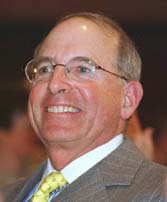
AMS was a very special company. Its president had been Charles Rossotti, whom then-Treasury Secretary Robert Rubin had named in 1998 to serve as Commissioner of the Internal Revenue Service. Rossotti got a special waiver to keep his AMS stock, and neither Rubin nor Rossotti seemed to see a conflict of interest when the IRS awarded contracts to AMS. Awarding new contracts would have been a violation of federal acquisition regulation, but top Clinton officials got around it by engineering a renewal of old AMS contracts that existed before the appointment rather than issuing new ones. Rossotti continued at the IRS under Bush II until 2002 and then joined the Carlyle Group as senior adviser for information technology.
Cuomo resigned as HUD Secretary in 2001 when George W. Bush took office. Throughout Cuomo’s tenure, HUD’s Single-Family Mortgage Insurance Program remained on the annual General Accounting Office (GAO) list of federal programs vulnerable to waste, fraud, abuse and mismanagement.
Part 2: The Vendetta
* * * *
Postscript
In September 2004, Assistant FBI Director Chris Swecker warned of an epidemic of mortgage industry fraud that could become the next S&L crisis. Under Reagan deregulation in the 1980s, fraud by savings and loans — including one whose board included Neil Bush, the then Vice-President’s son — cost taxpayers $132 billion.
MAKING FEES FOR HIMSELF

When Cuomo fired Hamilton and ended the mortgage auctions, two of the biggest beneficiaries were the National Housing Partnership (NHP) and Andrew Farkas’ Insignia. Farkas became one of Cuomo’s major fundraisers in his unsuccessful run for the 2002 Democratic nomination for New York governor. Cuomo needed a job in 2003 and found a lucrative one at Island Capital, which Farkas founded that year. Cuomo advised developers in Dubai (the United Arab Emirates), and lobbied for development of a luxury waterfront project in the U.S. Virgin Islands which community groups opposed, because they said the buildings were too high and would block public access to the shore. Cuomo reported 2003 income of $288,983, but with $660,238 from Farkas, that jumped to $819,473 in 2004. Cuomo told Anna Schneider-Mayerson of The New York Observer that he took the job, because, “I didn’t want to do work that would bring me into the HUD world, so to speak.”


I have been working as an organizer in HUD buildings since 1996. Your article is a great reminder of how little things change.
Chris Greer was one of the best people to ever come out of HUD. I would very much like to get in touch with him. If you are liberty to share his contact information, it would be greatly appreciated.
Wow, what a thorough and well written article on HUD’s dysfunctionality.
Cuomo CANNOT become attorney general.
Pingback: The Catherine Austin Fitts Blog » Top Picks ~ Week of August 21, 2006
I’ve been aware of Catherine Austin Fitts’ story for some time now. Thank you for writing a concise and thorough synapsis of the frauds and gubmint’ work.
I would suggest advertising this article on the NY political blogs:
http://blogs.nydailynews.com/dailypolitics
http://blogs.timesunion.com/capitol
http://thepoliticker.observer.com
http://empirezone.blogs.nytimes.com
Hi Lucy I read your article. Thank you. This information is too important not to get out. Banks have abused SBA also. I am not a writer. Just a former business owner. Things were so out of hand by 2000 and no one was looking that I could find. I read OIG reports of the same tactics being used on disaster loans, Small Business Administration loans, now on student loans. In 2003 I found a lot more information on the internet than I can find now. I read report after report of the large banks giving false information on audits.
Wells Fargo created a lot of false documents in my SBA loan file, misreported funds, and gave false information to SBA. I was buried by Wells Fargo when I refused to give my signature to them on a waiver for anything they had done wrong. All of the pieces started fitting into place once I was able to start searching. Wells had 33% of the retirement fund in Martin Marietta stock. Martin Marietta tried to but the use of my name wanting me as a partner but control of my mine. I had no clue that at that time Wells Fargo had filed a false UCC filing claiming the mine property at the onset of my SBA loan.
In 2002 Wells Fargo literally took any viable means of support from my husband and myself when I refused to sign their waiver. It takes days to write down all that transpired. We spent the next few years learning how to defend oneself legally. It simply can’t be done by a person when they have no financial means and no legal background. In my loan file at SBA I found a document that read “ROBEX INC” on one line, then “GOURMET GRINDER INC” on another line where my business name belonged.
Banks get people to sign off so these matters will not get looked into. The banks then collect from the federal government. The people have to pay the fraud of these banks twice. Once in their property. Then in larger tax bites. The majority of people out there are simply trying to feed and house their families each day.
In all my frustration I kept a watch on blogs or forums over the last few years. They disappear into cyber space and these people who have been cheated their voices are lost.
I started writing a blog last week. It was stopped cold before the week was out. My home email rodni@grm.net
Excellent article! I applaud you for helping to spread the truth about Catherine’s goodness, talents & innocence – as well as the government corruption! We need more writers like you, who have no fear of writing the truth.
Pingback: Another Unanswered Question at The Catherine Austin Fitts Blog
Wow, thanks for a brilliantly, and in depth article. I felt like a load had been lifted the first evening I heard “Austin” on the Dennis Bernsteir, Flashpoints show recently, and continue to be amazed. How lucky we are to have such a resource. Been thinking for some time, that although activism in all the fronts today is necessary, she nailed the cornerstone so well, that unless we change the financial system, the political system, democrat or republican will go on ad infinitum. So many crooked people inside, so few ethical, honest, and with credibility, who actually stay strong after what she went through, to go on sharing.
I already have some money local, and have to check out other accounts to see if I need to move them, peanuts in terms of amounts, but I am taking her advice whenever possible. Unfortunately, I really have not say in my retirement PERS, as we have no right of management of funds, and I know from several articles, that they have made some “mistakes”, perhaps they are part of the problem, as are JP Morgan, etal., as well.
Thanks again for your effort in publicizing this wonderful article. My biggest sorrow to date is that this information has come to me so late in the game, but better late than never, and I have retirement to look forward to in 1.5 years, and will be doing as many seminars with Catherine Austin Fitts audios as I can possible afford.
Pingback: Andrew Cuomo Affair: Explosive Scandal Allegations Rock New York Governor Race! » Right Pundits
Pingback: Math, Banking & War = Every Seventy Years? 1791 . . .1861 . . .9/10/1931 . . . 9/11/2001 . . . . « Let'sGetHonestBlog
Pingback: ” Andrew Cuomo’s Predatory Heart Of Darkness ” Eliot Bernstein, Iviewit Inventor Supports Terence Finnan’s claims of Cuomo’s Heart of Darkness, THE HORROR, THE HORROR, THE HORROR. Cuomo Defendant in Trillion Dollar Fed RICO &
Pingback: Dear Clueless in Albany (a/k/a Andrew Cuomo) - Natural Gas Now
Pingback: Fees for Friends: Vendetta [Andrew Cuomo Scandal] | The Komisar Scoop
Pingback: The Corruption of Gov. Andrew Cuomo | The Komisar Scoop
Pingback: †Andrew Cuomo’s Predatory Heart Of Darkness †Eliot Bernstein, Iviewit Inventor Supports Terence Finnan’s claims of Cuomo’s Heart of Darkness, THE HORROR, THE HORROR, THE HORROR. Cuomo Defendant in Trillion Dollar Fed RICO & ANTITRUST Lawsu
Pingback: Right-Sizing HUD | WYOMING DAILY INDEPENDENT
Pingback: Unpacking Astonishing Financial Fraud with Lucy Komisar – The Komisar Scoop
Pingback: #HIDDENENEMY: 5G, Fauci (V) Captured, TRUMPing CV/DS #SB893 – NATION AND STATE
And here we are in 2020 and this article is more relevant than ever. I have referred people to this article many times over the years. Your work proved invaluable.